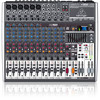Behringer XENYX X1832USB Manual - Page 9
Interface panel and main
 |
View all Behringer XENYX X1832USB manuals
Add to My Manuals
Save this manual to your list of manuals |
Page 9 highlights
9 XENYX X2442USB/X2222USB/X1832USB/X1622USB User Manual LOW CUT and MIC GAIN AUX SEND 1, 2 and 4 These two control elements operate on the XLR connectors of the X2442USB, and are used to filter out frequencies below 75 Hz (LOW CUT) and to adjust microphone levels (MIC GAIN). LINE GAIN The AUX SEND 1 control governs the master send level of the mix created by the individual channel AUX 1 sends. Likewise, the AUX SEND 2 contol is the master control for the aux 2 bus, and AUX SEND 4 controls the AUX 4 bus. Use this control to adjust the line signal levels on channels 13-16 (X2442USB only). LEVEL For level matching, the stereo inputs on the X1622USB, X1832USB and X2222USB have a LEVEL switch to select between +4 dBu and -10 dBV. At -10 dBV (homerecording level), the input is more sensitive than at +4 dBu (studio level). 2.2.2 Equalizer stereo channels The stereo channels contain a stereo EQ section. The cut-off frequencies of the high and low bands are 12 kHz and 80 Hz respectively, while the center frequencies of the high-mid and low-mid bands are 3 kHz and 500 Hz respectively. The HIGH and LOW controls have the same characteristics as the EQ in the mono channels. Both mid range bands are of the peak filter type. A stereo EQ is superior to two mono EQs on a stereo signal as two separate EQs will usually result in a discrepancy between left and right channels. 2.2.3 Aux sends stereo channels In principle, the aux sends of the stereo channels function the same way as those of the mono channels. As the aux sends are mono, the send from a stereo channel is first summed to mono before it reaches the aux bus. X2442USB Fig. 2.7: The AUX SEND controls of the main section! AUX SEND 3 (FX) The FX control determines the signal level for effects processing, i.e. regulates the level to an external (or the internal) effects device. X1622USB and X1832USB: On these consoles, this function is performed by the AUX SEND 2 control (FX). 2.2.4 Routing switch, solo and channel fader SOLO You can use the SOLO switch to separately monitor the aux sends via the CONTROL ROOM/PHONES outputs and check these with the level meters. Fig. 2.6: Balance control and mute switch ◊ If you want to monitor the signal of just one AUX bus, none of the other SOLO SWITCHES should be pressed and the MODE switch should be in the SOLO position (not depressed). 2.3.2 Aux send jacks BAL The BAL(ANCE) control has a similar function to the PAN control in the mono channels. The balance control determines the levels of the left and right input signals relative to each other before both signals are routed to the left/right main mix bus (or odd/even subgroup). X2442USB X1832USB The remaining control elements in the stereo channels perform the same functions as their counterparts in the mono channels (MUTE switch, MUTE and CLIP LEDs, SOLO switch, SUB and MAIN switches and channel fader). Fig. 2.8: Aux send jacks AUX SEND jacks 2.3 Interface panel and main section Where it was useful to trace the signal flow from top to bottom in order to gain an understanding of the channel strips, we now look at the mixing console from left to right. The signals are, so to speak, collected from the same point on each of the channel strips and then routed to the main section all together. The AUX SEND jack should be used when hooking up a monitor power amp or active monitor speaker system. The relevant aux path should be set pre-fader. ◊ On the X2222USB, aux send 1 is hard wired as pre-fader and hence called MON. Model X1832USB has a dedicated monitor output (MON OUT jack), cf. chapter 2.3.4. 2.3.1 MON control, aux sends 1, 2 and 3 (FX) As already mentioned, the aux sends in the channels- if set post-fader- can be used to connect to external effects devices. Turning up the AUX 1 control in a channel routes the signal to the aux send bus 1. ◊ As the X1832USB is equipped with an additional monitor path, its first aux control in the channel strips is named MON. The console also has a dedicated master fader (MON SEND) for this aux path.















